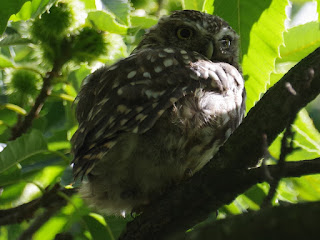... leaving a sticky green thread which the larva had trailed round the twig.
The young Starlings are growing their iridescent adult feathers.
There are two young Robins in the Rose Garden. They too are beginning to get their adult colour.
The female Little Owl near the leaf yard was enjoying the sunshine.
The Great Crested Grebes nesting in the fallen poplar on the Long Water have lost their one chick, and are starting again. It would be their third brood. They haven't been successful, but there's still plenty of time.
I could only see two chicks of the other family on the Long Water. They are now quite large, but still rushing around around demanding food. This video was taken looking down from the Serpentine bridge, with inevitable traffic noise in background.
One of the parents has been on their nest -- too far away for an adequate picture -- for several days. They may also be thinking of another brood. Their chicks are about the same age as the teenage grebe on the Serpentine was when it was abandoned, and survived. (I haven't seen it for a couple of days, but it tends to stay in cover on the edge of the island.)
A Mute Swan was washing furiously on the Long Water, with the light behind it.
The Black Swan was near the Lido, dozing on one leg.
This goose on the Serpentine is so large that it has to be a Canada--Greylag hybrid, but it's oddly pale. If it were not for its size I would have taken it for a Greylag--Bar-Headed cross.
A juvenile gull, probably a Lesser Black-Back, balanced uncertainly on one of the mooring buoys on the Serpentine. Young gulls love pulling rope ends.
A Greenbottle fly wandered over a marigold behind the Lido.
There was also a bee-mimicking hoverfly. I wouldn't like to guess its species -- there are about 6o00.
Here is a real honeybee for comparison.


















































